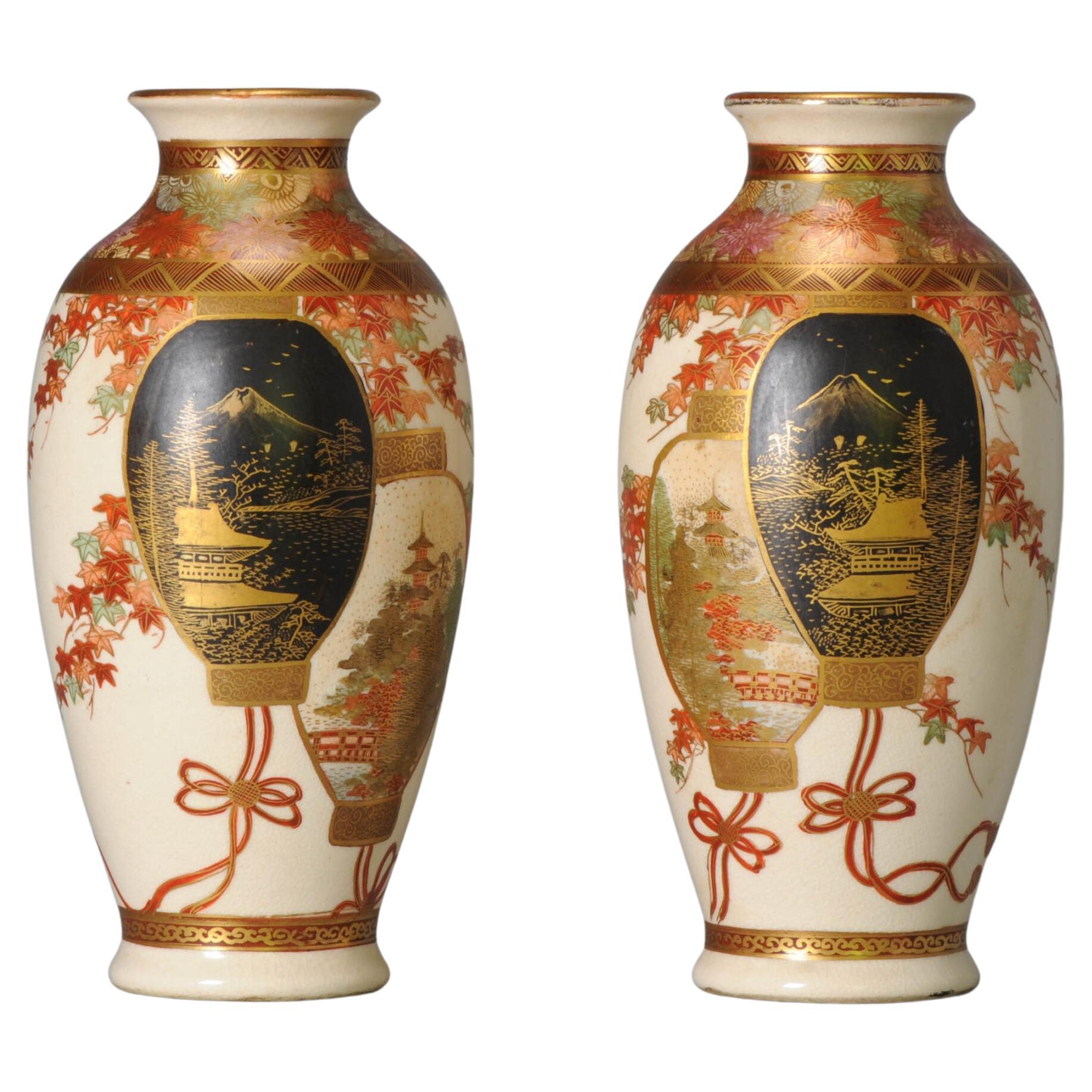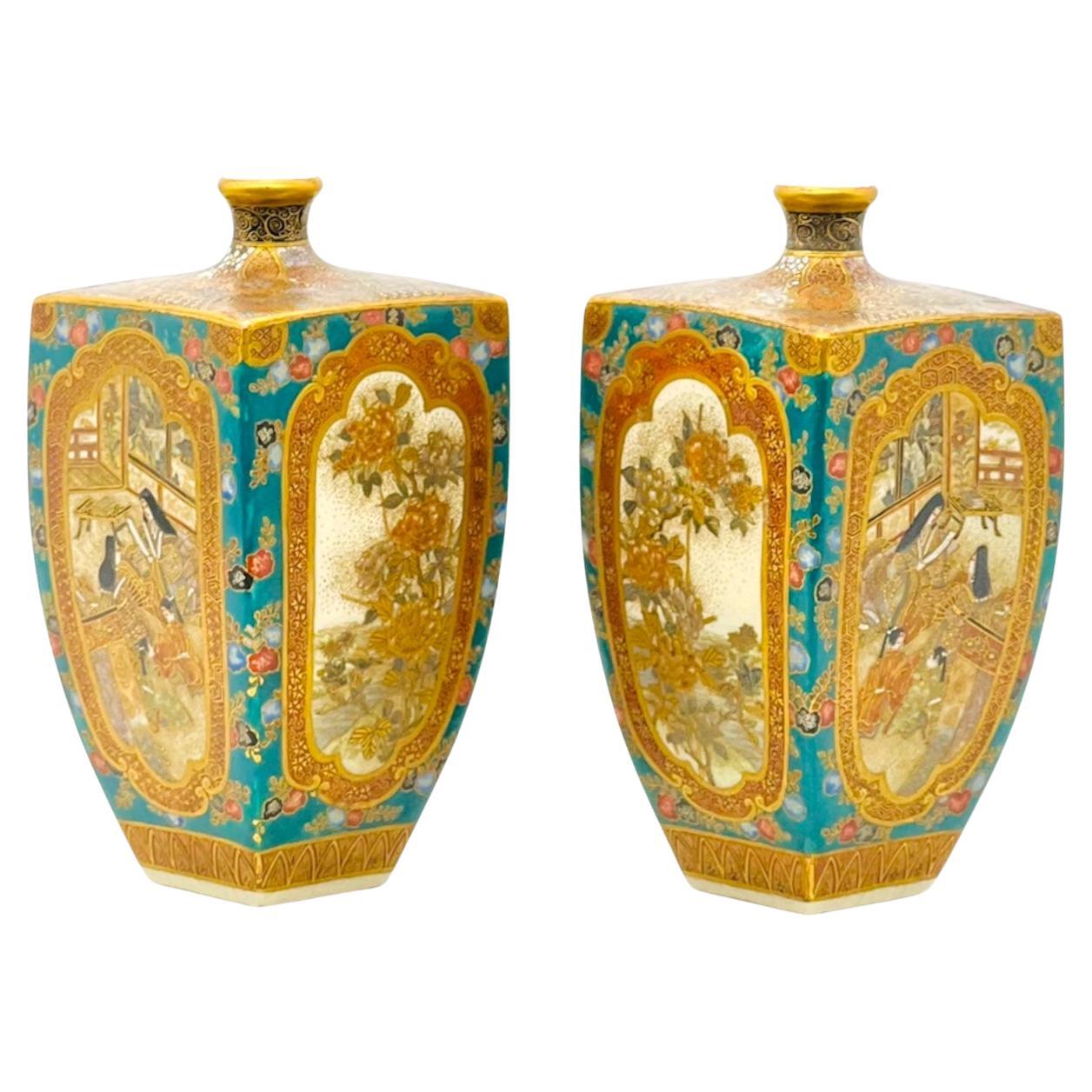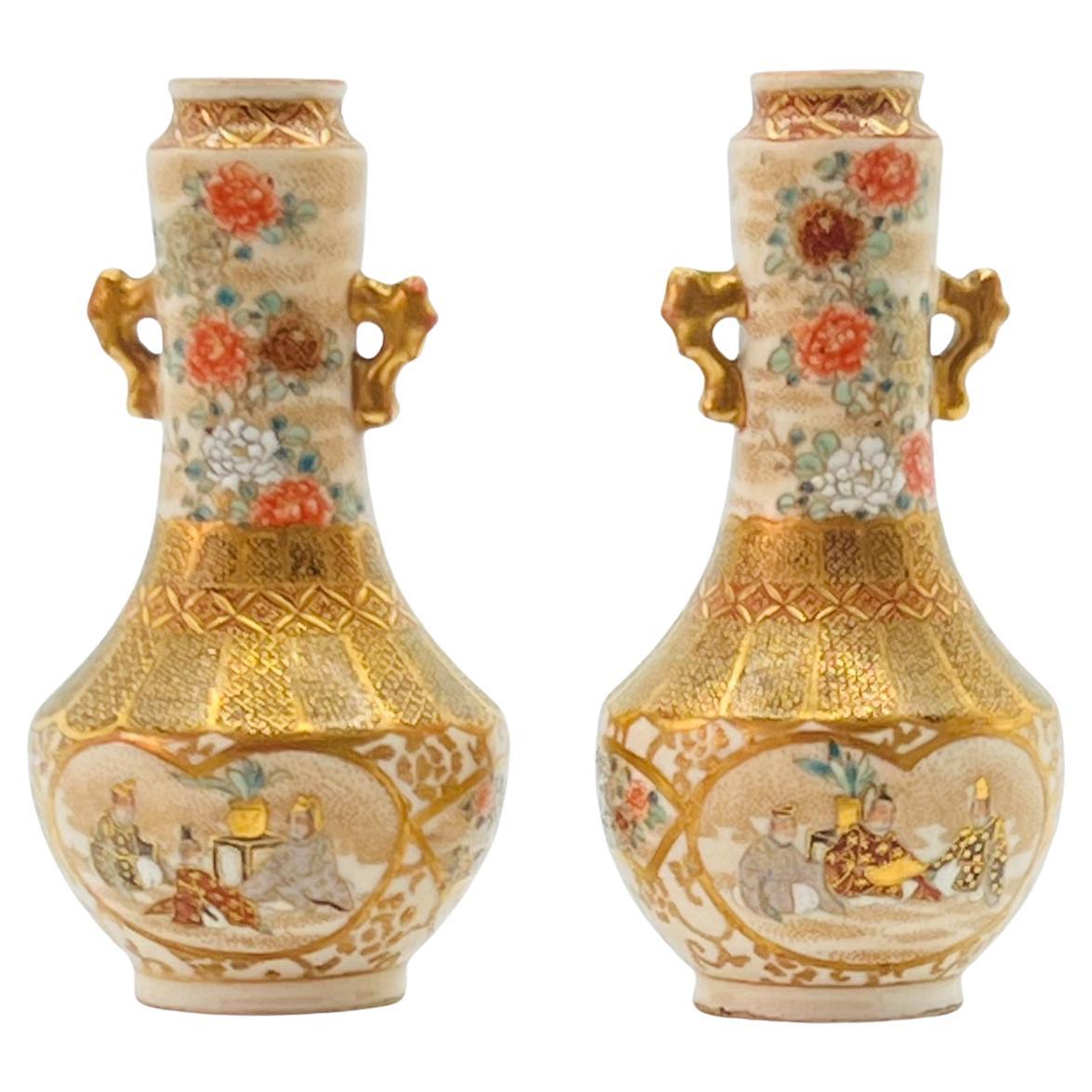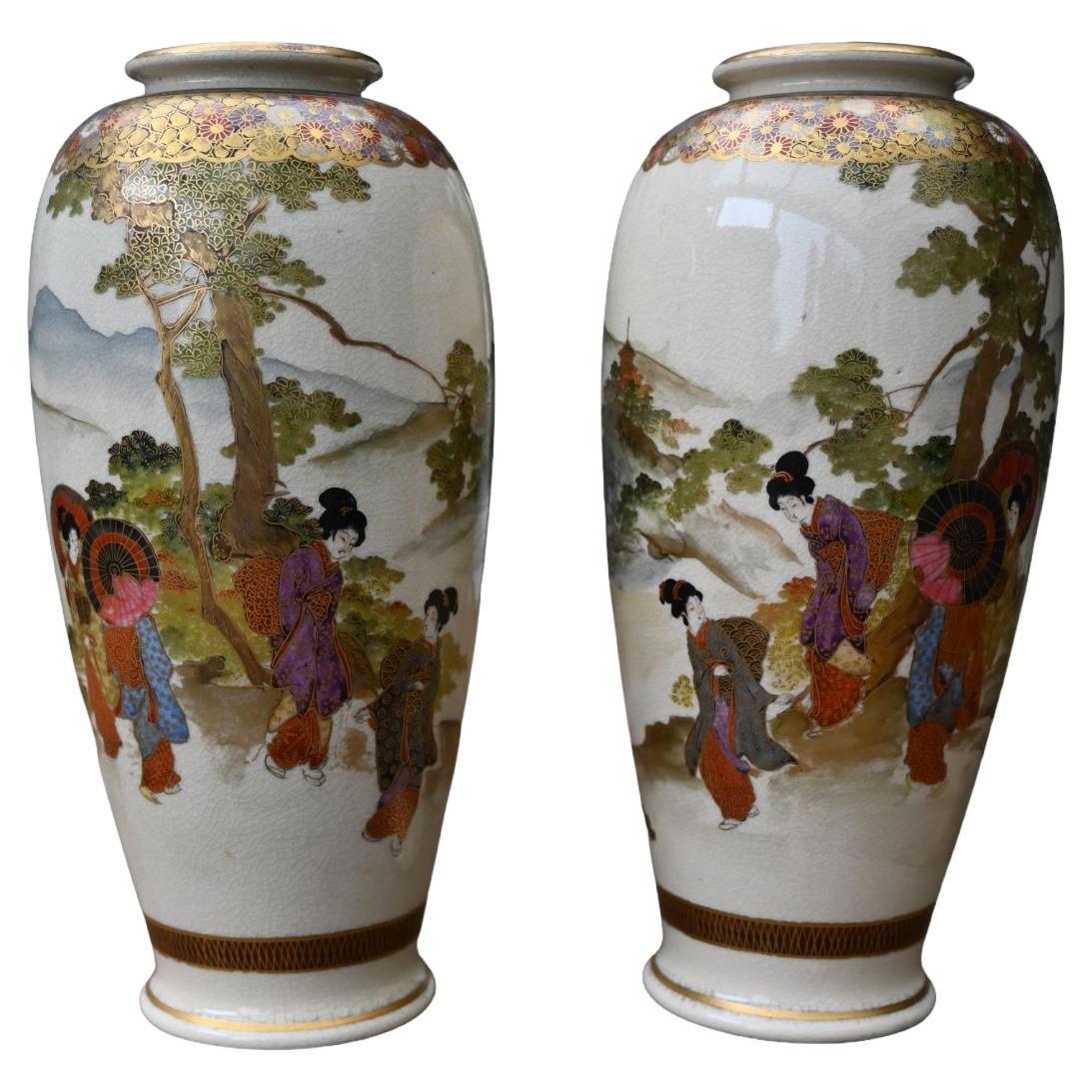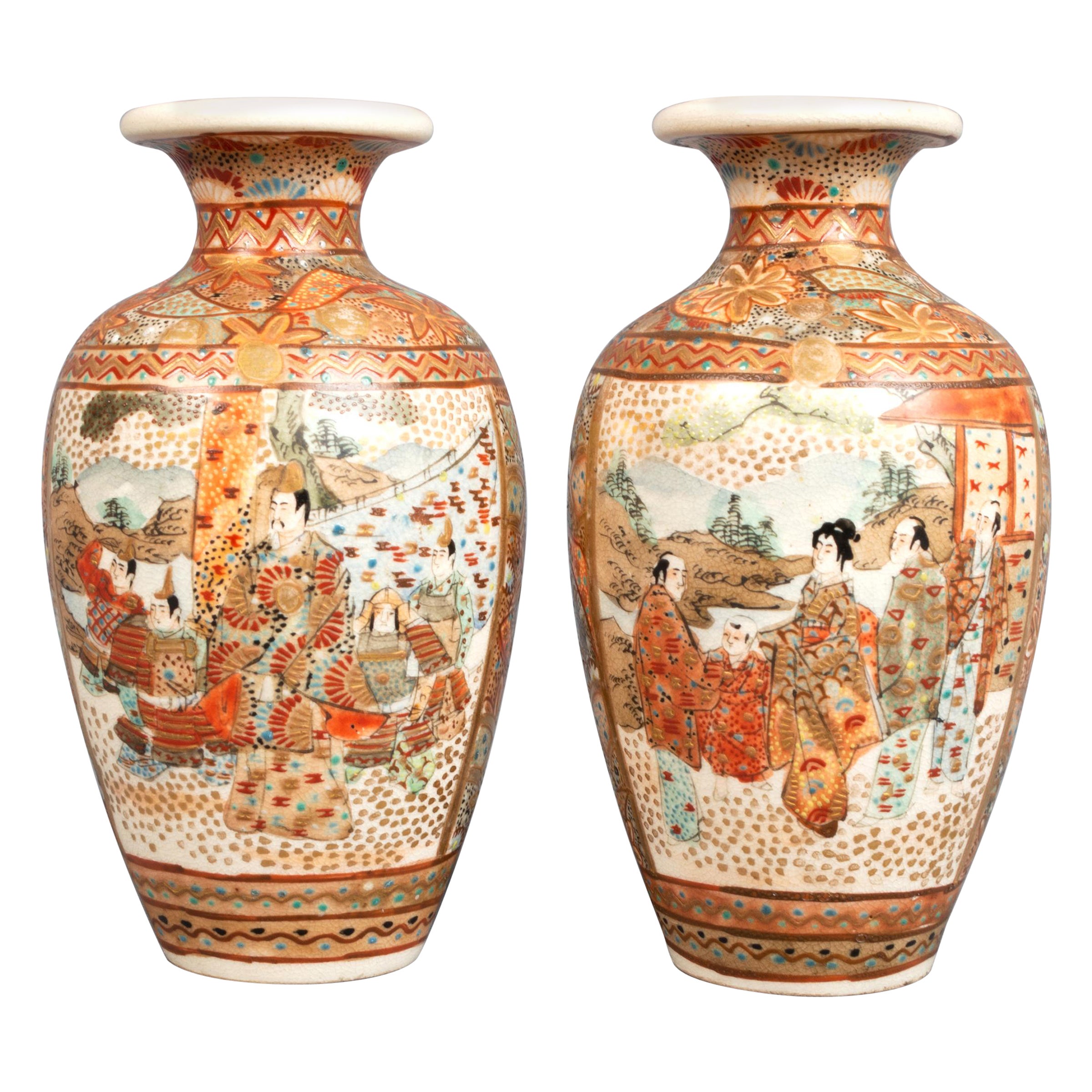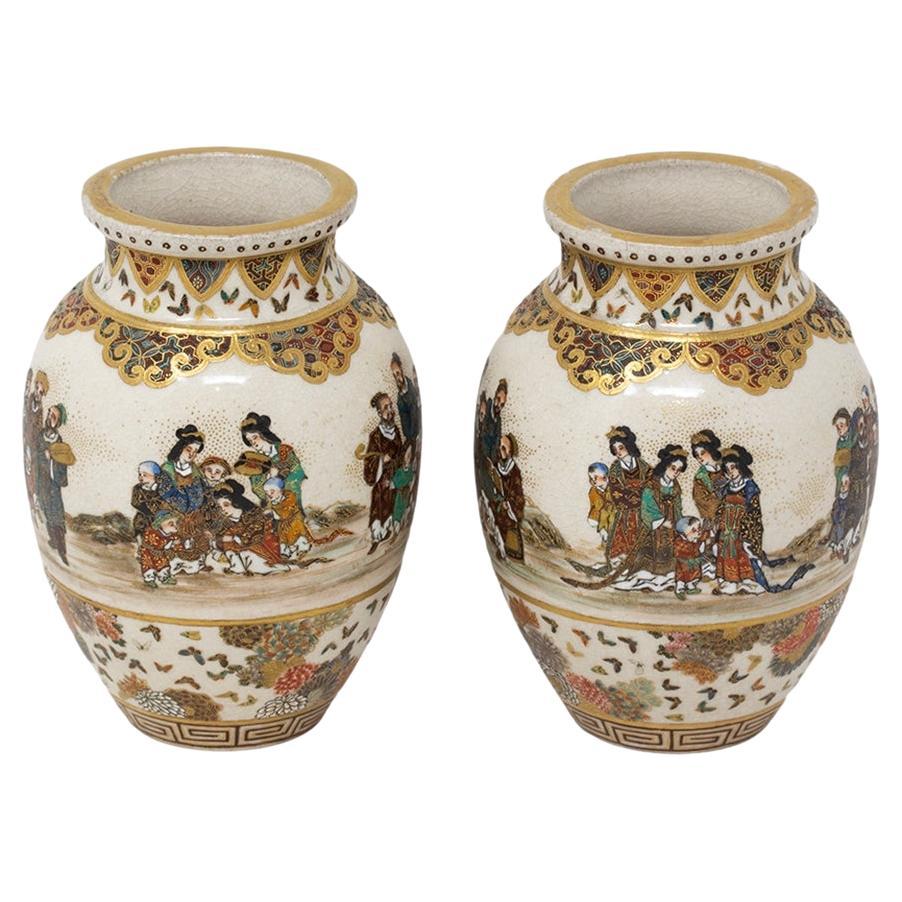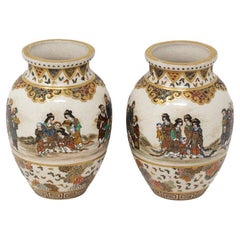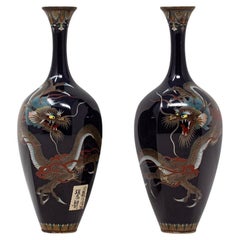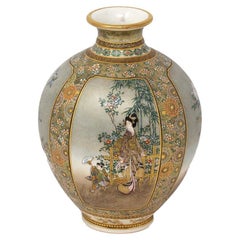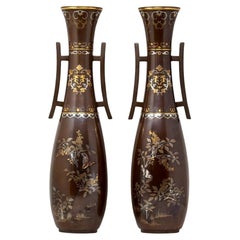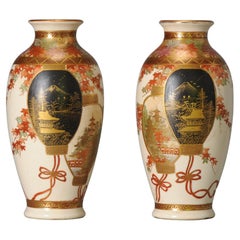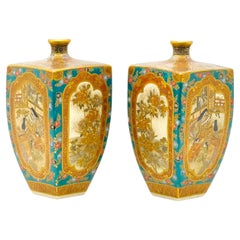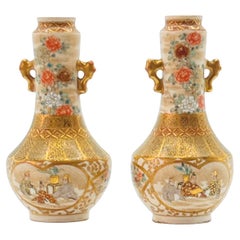Items Similar to Unusual Pair of Japanese Meiji Period (1868-1912) Satsuma Vases by Kinkozan
Want more images or videos?
Request additional images or videos from the seller
1 of 20
Unusual Pair of Japanese Meiji Period (1868-1912) Satsuma Vases by Kinkozan
$5,754.70
£4,200
€4,899.07
CA$7,882.50
A$8,767.06
CHF 4,577.89
MX$106,685.81
NOK 58,466.60
SEK 54,831.36
DKK 36,563.67
Shipping
Retrieving quote...The 1stDibs Promise:
Authenticity Guarantee,
Money-Back Guarantee,
24-Hour Cancellation
About the Item
Taizan Yohei IX Style
From our Japanese collection we are delighted to offer this pair of Japanese Satsuma Vases by Kinkozan. The Satsuma Vases of baluster shape made from earthenware with flared rims and slightly waisted necks beautifully decorated with a blue to white base glaze. The bodies of the vases are painted with a very subtle sprig of foliage having blossoming flowers at the extremities with polychrome colours and floating butterflies around the top third. The bases of the Satsuma Vases are signed Kinkozan and date to the late Meiji Period (1868-1912) circa 1900.
Kinkozan the Kinkozan family have been associated with pottery dating back to 1645. They went on to become the largest producer of Satsuma ware by one individual company, from the end of the 19th century until 1927 after which the factory closed. By the 1850s Kobayashi Sobei (1824-84), Kinkozan Sobei (artist name Kinkozan IV), started to export his products together with the Kyoto manufacturer Taizan VIII. The main target market was America with their main production period approximately between 1875-1927 under the leadership of Kinkozan V(1868-1927).
Meiji Period was an era of Japanese history that spanned from 1868 to 1912. It was the first half of the Empire of Japan, when the Japanese people began to build a paradigm of a modern, industrialised nation state and emergent great power, influenced by Western countries and aesthetics. As a result of radically different ideas, the changes to Japan were profound and it affected the social structure, politics, economy, military, and foreign relations across the board. The period corresponded to the reign of Emperor Meiji and was preceded by the Keio era and was succeeded by the Taisho era.
Cultural Art during the Meiji Period was of particular interest to the government and they overhauled the art export market which in turn promoted Japanese arts via various world’s fairs, beginning in Vienna at the world fair in 1873. The government heavily funded the fairs and took an active role organising how Japan’s culture was presented to the world including creating a semi-public company named Kiritsu Kosho Kaisha (First Industrial Manufacturing Company). The Kiritsu Kosho Kaisha was used to promote and commercialise exports of Japanese art and established the Hakurankai Jimukyoku (Exhibition Bureau) to maintain quality standards. For the 1876 Centennial International Exhibition in Philadelphia, the Japanese government created a Centennial Office and sent a special envoy to secure space for the 30,000 items that would be displayed. The Imperial Household also took an active interest in arts and crafts, commissioning works by select artists to be given as gifts for foreign dignitaries further emphasising the high quality and importance of Japanese art. Just before the end of the 19th century in 1890, the Teishitsu Gigeiin (Artist to the Imperial Household) system was created to recognise distinguished artists. These artists were selected for their exceptionally high quality wares and talent in their own industry. Over a period of 54 years Seventy artists were appointed, amongst these were ceramicist Makuzu Kozan and cloisonné enamel artist Namikawa Yasuyuki.
Satsuma ware is a type of earthenware pottery originating from the Satsuma province in Southern Kyushu, Japan’s third largest island.
Earthenware is a pottery ceramic that has not been fired to the point of vitrification and is therefore is slightly porous and coarser than stoneware and porcelain.
- Creator:Kinkozan (Maker)
- Dimensions:Height: 9.45 in (24 cm)Diameter: 4.93 in (12.5 cm)
- Style:Meiji (Of the Period)
- Materials and Techniques:
- Place of Origin:
- Period:1900-1909
- Date of Manufacture:Circa 1900
- Condition:Wear consistent with age and use.
- Seller Location:Newark, GB
- Reference Number:Seller: TIDDW1stDibs: LU6971240929862
About the Seller
5.0
Gold Seller
Premium sellers maintaining a 4.3+ rating and 24-hour response times
Established in 2019
1stDibs seller since 2022
37 sales on 1stDibs
Typical response time: 3 hours
- ShippingRetrieving quote...Shipping from: Newark, United Kingdom
- Return Policy
Authenticity Guarantee
In the unlikely event there’s an issue with an item’s authenticity, contact us within 1 year for a full refund. DetailsMoney-Back Guarantee
If your item is not as described, is damaged in transit, or does not arrive, contact us within 7 days for a full refund. Details24-Hour Cancellation
You have a 24-hour grace period in which to reconsider your purchase, with no questions asked.Vetted Professional Sellers
Our world-class sellers must adhere to strict standards for service and quality, maintaining the integrity of our listings.Price-Match Guarantee
If you find that a seller listed the same item for a lower price elsewhere, we’ll match it.Trusted Global Delivery
Our best-in-class carrier network provides specialized shipping options worldwide, including custom delivery.More From This Seller
View AllJapanese Antique Meiji Period Satsuma Vase Pair Hand Painted by Gyokuzan
Located in Newark, England
Painted with Continuous Scenes
From our Japanese collection, we are delighted to offer this Japanese Satsuma Vase Pair by Gyokuzan. The Satsuma vase pair of squat bulbous form with ...
Category
Antique Late 19th Century Japanese Meiji Ceramics
Materials
Ceramic, Pottery
Antique Japanese Cloisonne Enamel Vase Pair Hayashi School
Located in Newark, England
Meiji Period (1868-1912)
From our Japanese collection, we are delighted to offer this pair of Antique Japanese Cloisonne Enamel Vases by the Hayashi School in their Original Tomoba...
Category
Antique Early 1900s Japanese Meiji Metalwork
Materials
Metal, Enamel, Metallic Thread
Antique Japanese Meiji Period (1868-1912) Satsuma Vase by Kinkozan
By Kinkozan
Located in Newark, England
Signed Kinkozan 金光山
From our Japanese collection, we are delighted to offer this Japanese Satsuma Vase by Kinkozan. The vase is potted in globular form with a tightly pinched neck and rolled top rim beautifully decorated with four highly detailed individual panelled scenes. The first a Geisha baring a gilt basket with her child playing with a fan infant of a gilt fence encompassing blossoming foliage and bamboo plants. The second scene depicts two birds, a Red Headed Japanese Wood Pigeon and a white dove in the foreground with a similar gilt fence with blossoming kiku flowers (chrysanthemums). The third scene is painted as a bustling village community with multiple figures going about their daily jobs, a central Palanquins can be seen with two figures carrying a seating figure. To the background a mountainous river landscape can viewed bordering the top left corner. The final scene appears similar to the opposing one with birds swooping high above a polychrome Japanese...
Category
Antique Late 19th Century Japanese Meiji Vases
Materials
Ceramic, Earthenware, Pottery
Japanese Pair of Large Antique Meiji Period Bronze and Mixed Metal Vases
Located in Newark, England
Inlaid with Gold and Silver
From our Japanese collection, we are thrilled to offer a Japanese Pair of Meiji Period Bronze Vases. The Japanese Bronze Vases of elongated form each sur...
Category
Antique Late 19th Century Japanese Meiji Vases
Materials
Metal, Gold, Silver, Bronze
Japanese Meiji Period Satsuma Vase by Ryokuzan
Located in Newark, England
From our Japanese Satsuma Collection, we are delighted to offer this Japanese Satsuma Vase by Ryokuzan 緑山. The Satsuma vase of ovoid shape with a tapered body, circular foot rim, wai...
Category
Antique Early 1900s Japanese Meiji Ceramics
Materials
Ceramic, Earthenware, Pottery
Japanese Meiji Period (1868-1912) Satsuma Vase by Kinkozan
By Kinkozan
Located in Newark, England
JAPANESE SATSUMA PROCESSIONAL VASE
From our Japanese collection, we are delighted to introduce to the market this Japanese Satsuma Vase by Kinkozan. The vase with a compressed body ...
Category
Antique Late 19th Century Japanese Meiji Ceramics
Materials
Ceramic, Earthenware, Pottery
You May Also Like
Pair of Antique Meiji Japanese Satsuma Vases, 19th Century
Located in Amsterdam, Noord Holland
Amazing piece with beautiful decoration in different kind of panels. Visible are birds, flowers, objects and a cart. High quality painting.
Additional information:
Material: Porcela...
Category
Antique 19th Century Japanese Vases
Materials
Porcelain
$1,758 Sale Price / set
20% Off
A Rare and Important Pair of Satsuma Vases by Okamoto Ryozan, Meiji Period
Located in London, GB
A Rare and Important Pair of Satsuma Vases signed Okamoto Ryozan
Meiji period (late 19th century)
Kyoto, circa 1890
Exhibition Standard
Each of tapering square form with a short wai...
Category
Antique 19th Century Japanese Ceramics
Materials
Ceramic, Porcelain
A fine pair of Antique Japanese Satsuma vases. Signed Kyuozan.Meiji Era
Located in London, GB
A fine pair of Japanese satsuma vases.
Meiji period.
Signed by Kyokuzan
of globular body rising to a molded cylindrical neck with gilt handles , decorated to the body with pa...
Category
Antique Late 19th Century Japanese Ceramics
Materials
Ceramic, Porcelain
Pair Of Satsuma Earthenware Vases "zenkozan" Japan, Meiji Period
By Satsuma
Located in Bilzen, BE
Pair of Earthenware vases from Satsuma Japan
Each side with different decoration
Signature under the base "Zenkozan" end of the Meiji period
Height 22 cm
Perfect condition
Category
Early 20th Century Japanese Meiji Vases
Materials
Earthenware
Pair 19th Century Japanese Miniature Kutani Vases Signed Meiji Period, C.1880
Located in London, GB
A pair of 19th century Japanese miniature Kutani vases.
Meiji period C.1880.
Fine quality, hand painted with decorative and a figural panel ...
Category
Antique 19th Century Japanese Meiji Vases
Materials
Earthenware
Pair Japanese Export Vases Japan C.1900 Stamped 'Nippon'
Located in London, GB
A pair Japanese export vases
Japan C.1900
Stamped 'Nippon'
A beautiful pair of delicately designed earthenware vases of Western taste depicting a hand-painted botanical patter...
Category
Early 20th Century Japanese Meiji Vases
Materials
Earthenware
More Ways To Browse
Unusual Ceramics
Emperor Japan
Antique Pottery Names
Japanese Blue And White Ceramic
Satsuma Vases
Antique Satsuma Vase
Meiji Porcelain Satsuma
Centennial 1876
Satsuma Pottery
Circa 1900 Japanese Vase
Japanese Satsuma Pottery
Meiji Pottery Vases
Blue And White Blossom Vase
Satsuma Earthenware
Antique Japanese Stoneware
Empire Waist Top
Satsuma Style
Antique American Glaze Pottery
